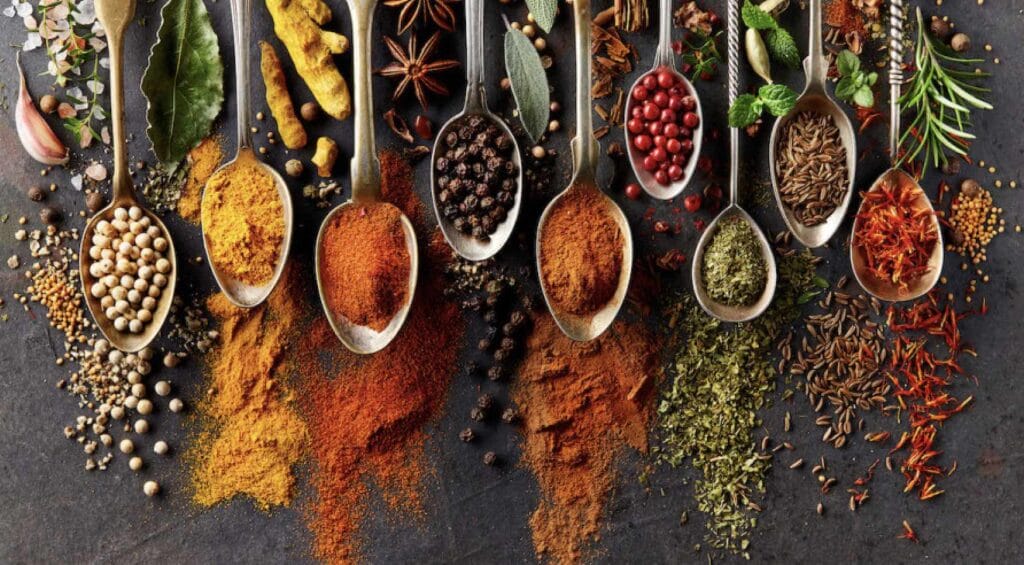Looking to spice up your life… literally? Look no further, because we’re bringing you the low-down of our top 5 most wanted super-spices, and why you should be including them in your diet!

Turmeric
This bright yellow curry staple packs a whole lot of punch, and not just when it comes to its colour. Its health benefits are vast, and with a gentle taste, it can be easily added to a range of dishes without it completely stealing the show. Lab studies have shown that it has a range of benefits, and can:
- reduce inflammation
- improve memory
- lower the risk of some chronic diseases
- fight against free radicals due to its antioxidant properties (see radicals are tissue-damaging molecules which contribute to ageing, but can also be a catalyst for chronic diseases, including cancer).
When cooking with turmeric, add a dash of black pepper to enhance the absorption of the curcumin (the active compound in turmeric).
Try it:
- whisked into scrambled egg
- sprinkles on your sautéed veggies
- stirred into soup
Remember a little goes a long way!
Ginger
For years people have been using ginger as a remedy for nausea and gastrointestinal issues. Whilst today this root is used more as a spice, it is still often called upon as a supplement to treat digestive problems. It is in fact closely related to Turmeric (google ‘Turmeric root’ to see it in its original form, and this will relation will make a lot more sense!), so unsurprisingly has a high level on antioxidants. So much so in fact, that only pomegranates and some berries contain more – so it’s up there with the highest antioxidant performers. With its antiemetic properties, it can also help combat:
- seasickness
- motion sickness
- and even morning sickness
Try it:
- grated fresh into curries
- ground, stirred into your overnight oats
- as a hot drink – simply pop a slice in a mug of freshly boiled water and allow it to steep before sipping
Cumin
Cumin is another big player in the curry game, popular for its aromatic effects. Not only does cumin have high antioxidant potential (there’s a bit fo a running theme here!) but it is also shown to be beneficial for:
- weight loss
- lowering cholesterol
- stress management
Early studies have shown that it could have anti diabetic effects too if taken regularly, so it could play a role in monitoring blood sugar levels too.
Try it:
- as a fajita mix / marinade, combined with smoked paprika and garlic
- sprinkled on veggies for roasting
- in a homemade curry
Cinnamon
Ancient civilisations have been using cinnamon for thousands of years for anointing, embalming and treating ailments. Although it’s not used as widely for its therapeutic benefits these days, it still provides a host of health benefits. It is said to be:
- antimicrobial
- antioxidant
- anti-inflammatory
- anti diabetic
- anticarcinogenic
Like cumin, there are also some small studies which show it may help reduce blood sugar levels, although these trials have been relatively small, so keep your eyes peeled on the research as we hope this unfolds to prove a more significant trend.
Similarly, Cinnamon is thought to have cognitive enhancement effects, and research is underway to establish whether the spice could be an effective treatment for Alzheimers. This would be a major leap forward in the treatment of this cruel disease.
Try it:
- folded into porridge
- sprinkled onto baked apple slices
- stirred into your morning coffee
Chilli and Cayenne
The active ingredient in chilli peppers (which makes them spicy) is called capsaicin, which has been shown to have a myriad of benefits. It’s said to:
- have some anticarcinogenic properties
- have cardiovascular benefits, helping reduce the risk of developing heart disease
- help reduce appetite, and in turn aid weight loss
- increase fat burning
Interestingly though, some studies showed that it was most effective in weight loss where the participants weren’t already accustomed to spicy food, whereas those who were used to regularly eating the spice didn’t see the same benefits, so it would suggest a tolerance can build up.
Try it:
- as part of a spice rub for meats
- chopped fresh into soups and ramen
- stirred into salsa as a spicy dip
Where to from here?
Are you thinking what we’re thinking? Yep, time to cook up some curries! The SCFIT Instagram (@secondcityfitness) is an excellent resource for healthy recipes, which includes a range of curries featuring these very ingredients. Click on the nutrition highlights tab to scroll through our featured recipes to save yourself spending hours scrolling! Homemade is always better than takeaway or shop bought – because not only do you know exactly what is going in them, you’re also in control of what isn’t going in there, so you can hold off on the unwanted preservatives and curb the unnecessary chemicals.
The awesome news is that spices can be acquired relatively cheaply, if you look in the right places! Instead of making a beeline for the rack of herbs and spices in the supermarket, check out the world foods aisle. Here you can typically find much bigger bags of the good stuff for a fraction of the price. Or, if you’re concerned you won’t get through such a hearty helping, consider stocking up from a zero-waste shop where you will be able to buy spices by the gram so you can buy the exact amount you need. For local readers, check out The Clean Kilo – just remember to bring your own container!
Sources: Healthline, Medical News Today, Eat Healthy with Chelsea
